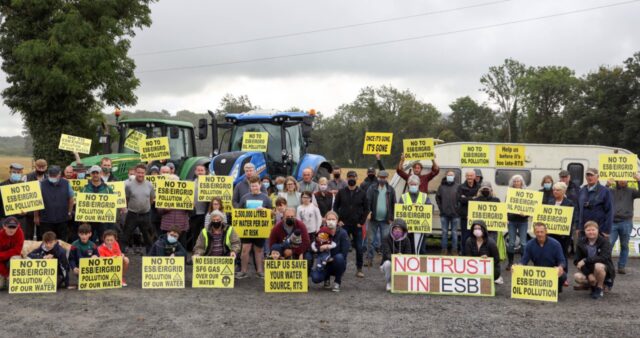The discontent of the local community with the coming Coolnabacky Substation in Ratheniska continued this week, with questions being raised over the legitimacy of a recent Risk Assessment.
Locals have been opposed to the location of the substation since it was first brought to light 14 years ago.
A Risk Assessment, carried out by Malone O’Regan Environmental, published in January of this year was designed to alleviate the concerns of the local community, but it has failed to do so.
Laois County Council have accepted the findings of the Risk Assessment and issued the CEMP and compliance letter which means the project can proceed.
Four local Cllrs raised the issue at the February meeting of Laois County Council earlier this week, with a number of local residents also present.
Fianna Fáil Cllr Padraig Fleming, Sinn Féin Cllr Aidan Mullins, and Independent Cllrs Aisling Moran and Ben Brennan brought the motion before the Council.
Sinn Fein Councillor Aidan Mullins previously stressed that the Risk Assessment was not the reason work had been halted on the site – but rather the fact that planning regulations had been broken.
The Councillors called on Laois County Council to “ask ESB Networks/Eirgrid to show what provisions will be in place for an alternative water supply for over 25,000 people in Laois including homes, businesses, farms, schools, nursing homes etc in the event of a catastrophic failure on site at the Coolnabacky Substation as mentioned in the independent Risk Assessment.”
Speaking on behalf of the group, Cllr Fleming said:
“This substation is going to be built almost on an aquifer which supplies water to between 20,000 and 25,000 people in homes, schools, and businesses.
“The Risk Assessment carried out did not go far enough as it relied solely on the documentation provided by Eirgrid/ESB, and has amounted to no more than a desktop study.
“We asked for a comprehensive Risk Assessment – they did not even visit the site.
“ESB’s record of pollution incidents and non-reporting of pollution was exposed on RTÉ Prime Time Investigates.
“This has shown ESB to be very poor at maintaining the type of equipment and infrastructure that will be at Coolnabacky.
“The Risk Assessment talks about a ‘catastrophic failure’ and they also said that to us verbally. That really shocked everybody.
“All state bodies have passed responsibility on who is responsible for the water supply in this community.
“There is over 200km of pipe, seven reservoirs, and a waterflow of over 3.5 million litres per day.
“Some say it is Eirgrid/ESB; others say Laois County Council.
“Irish Water have a very clear view on this; they say that the Council are responsible for the water under the ground – they are only responsible for the water over the ground.”
The conclusions of the Risk Assessment were as follows:
“The overall Permitted Development will pose no significant risk to the Kyle Spring PWS during either the construction or operational phases due to the lack of a pathway:
“The as the underlying aquifer is protected by an aquitard; the Kyle Spring is located approx. 1.2km cross/upgradient.
“Under most reasonable circumstances, if oil leaks or spills were to occur, they would be retained by the onsite containment measures (transformer bunds and full retention oil separator) and there would be no loss of containment or risk to the environment.
“In regard to the transformer oil, two exceptional (and highly unlikely) hypothetical scenarios have been identified in which loss of containment could occur:
“Large volume release (exceeding 500L) of transformer oil to the concrete roadway next to the transformer bunds whilst filling the transformers; and Catastrophic release of a large volume of oil from the transformer together with bund failure (e.g. due to explosion/total failure of containment).
“The risk from both of these hypothetical scenarios was assessed in relation to the CSM and both would result in severe impacts to receiving surface water bodies including the tufa springs.
“However, given the design and implementation of the proposed control measures, it is considered extremely unlikely that such scenarios would occur and so the overall risk to these surface water bodies was assessed as low.
“Neither of these extreme and hypothetical scenarios would result in a risk to the Ballyadams Formation aquifer, Timahoe gravel aquifer or Kyle Spring PWS due to lack of a pathway.
“The risk from SF6 gas during the operational phase was assessed in relation to the CSM. This showed that there would be a moderate risk to local residents and the atmosphere in a release scenario.
“However, a release scenario of the SF6 gas is extremely unlikely and the overall risk was assessed as very low.
“Notwithstanding the low risks associated with such extreme scenarios, additional mitigation measures have been recommended to provide further reassurance to the RTS Group.
“It has been confirmed that no other chemicals or fuel will be stored on site during the operational phase thereby negating any potential risk.
“There was no risk identified from on-site construction activities to the Ballyadams Formation aquifer, Timahoe gravel aquifer or Kyle Spring PWS due to lack of a pathway.
“There would be a moderate impact to receiving surface water bodies from sediments if there was a complete failure of all construction mitigation measures during an adverse weather event.
“However, it was deemed extremely unlikely that such events would occur all at once specifically if mitigation measures were monitored as per the recommendations and therefore the overall risk to surface water bodies was assessed as low.
“The risk from fuels/ chemicals during the construction phase was assessed in relation to the CSM. This showed that there would be a moderate risk to surface water in a release scenario.
” However, due to the proposed mitigation measures in the CEMP and volumes of fuel / chemicals that will be on-site during the construction phase, it is extremely unlikely that such scenarios would occur and so the overall risk to surface water bodies was assessed as very low.
“The risk from potential temporary noise nuisance during the construction phase was assessed in relation to the CSM.
“This showed that there would be a mild risk to local residents during the construction work.
“However, due to the proximity of the nearest sensitive receptor and operational measures detailed in the CEMP, it is unlikely that any noise nuisance impacts will arise and so the overall risk to local receptors was assessed as low.
“In conclusion, MOR expresses overall satisfaction, emphasising that, contingent upon the proper implementation of all proposed mitigation measures and the additional recommendations outlined in this report, there is confidence that these measures will be adequate to effectively mitigate any significant environmental incidents throughout all phases of the Permitted Development.”
The Cllrs were unable to clarify who has responsibility for the water.
SEE ALSO – In Pictures: Farmers protest at Laois County Council over ‘lack of funding’ and ‘over-regulation’























